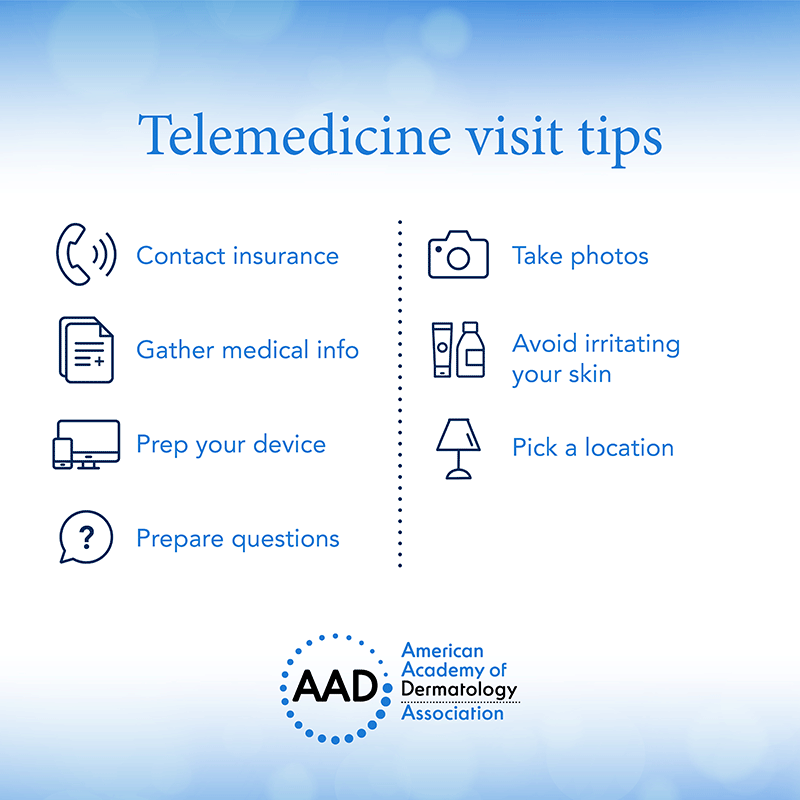Telemedicine: How to prepare for your appointment
How to prepare for a telemedicine appointment
To help patients get the most out of their telemedicine appointments, board-certified dermatologists recommend following these tips.
7 simple steps to prepare for your telemedicine appointment
To get the most from your telemedicine appointment, board-certified dermatologists offer these tips:
Contact your insurance provider to find out if your plan covers telemedicine appointments. After the coronavirus pandemic, many insurance providers are updating their plans to cover telemedicine visits. Find out what type of telemedicine visits are covered by your insurance.
Gather essential information. This is especially important if you have a telemedicine appointment with a dermatologist you haven’t seen before. Knowing your medical history will help your dermatologist make a diagnosis, decide treatment options, and prescribe medicine, if necessary. Ask your dermatologist’s office if they have any forms you need to fill out before your appointment.
Find out how to reach your dermatologist. Talk to your dermatologist’s office to make sure you know what type of telemedicine appointment you will have, and how your dermatologist will reach out to you. Ask when and how to send the pictures and information you gather.
Write down all your questions. Doing this helps you remember everything you plan to talk to your dermatologist about and make the most of your appointment.
Take pictures. To help your dermatologist examine your concern, take pictures that clearly show the areas you need examined. You want to take multiple, well-lit pictures of the area.
Before taking pictures, remove makeup from skin you want examined and nail polish if your dermatologist needs to examine your nails.Avoid irritating your skin before your appointment. Try to avoid doing things that could change the appearance of your skin before you begin your telemedicine appointment or take your pictures. Some examples of things to avoid are taking a hot shower, rubbing or picking at your skin, or applying skin care products.
Find a private space. Find a quiet and private space without distractions to have your appointment. Make sure you can connect to the internet in that space and it has the best-possible lighting.
Doing these things before your telemedicine appointment begins will help you get the most out of your telehealth appointment and the dermatologic care you need.

What to ask at the end of your telemedicine appointment
At the end of your telemedicine appointment, ask your dermatologist:
How will you follow up with me? That way, you won’t miss important information. For example, your dermatologist may call or email you with information about your visit.
How should I send you information? For example, your dermatologist may want you to take and send pictures of your condition. To protect your medical information, always use the method that your dermatologist recommends.
Do you have a patient portal? A portal offers you a convenient and secure way to communicate. Your dermatologist may send you a message through the portal or put information in there about how to care for your condition at home.
Your dermatologist may want to have another appointment with you — whether it’s an in-person visit or another telemedicine appointment — to see if your skin condition is improving. Keep any follow-up telemedicine or in-person appointments that your dermatologist recommends.
Reviewed by:
Hassan I. Galadari, MD, FAAD
Mona Gohara, MD, FAAD
Roopal Kundu, MD, FAAD
Ivy Lee, MD, FAAD
Jennifer G. Powers, MD, FAAD
Sanna Ronkainen, MD, FAAD
Last updated: 8/18/23
 Atopic dermatitis: More FDA-approved treatments
Atopic dermatitis: More FDA-approved treatments
 Biosimilars: 14 FAQs
Biosimilars: 14 FAQs
 How to trim your nails
How to trim your nails
 Relieve uncontrollably itchy skin
Relieve uncontrollably itchy skin
 Fade dark spots
Fade dark spots
 Untreatable razor bumps or acne?
Untreatable razor bumps or acne?
 Tattoo removal
Tattoo removal
 Scar treatment
Scar treatment
 Free materials to help raise skin cancer awareness
Free materials to help raise skin cancer awareness
 Dermatologist-approved lesson plans, activities you can use
Dermatologist-approved lesson plans, activities you can use
 Find a Dermatologist
Find a Dermatologist
 What is a dermatologist?
What is a dermatologist?